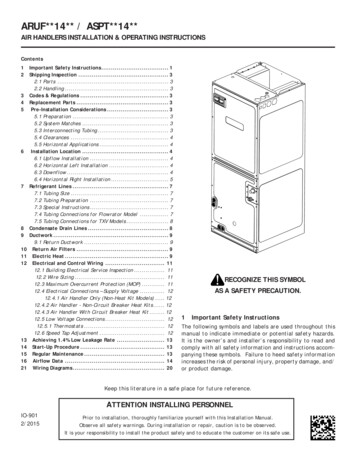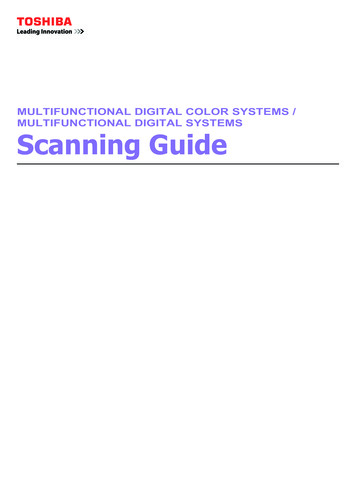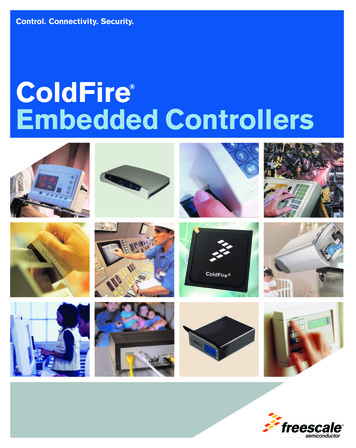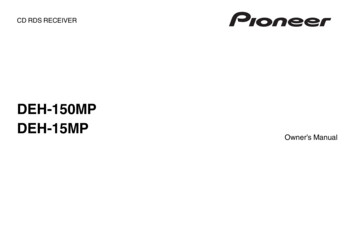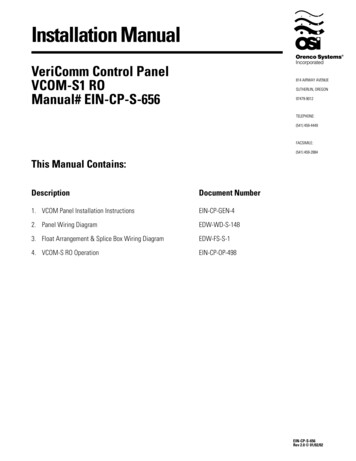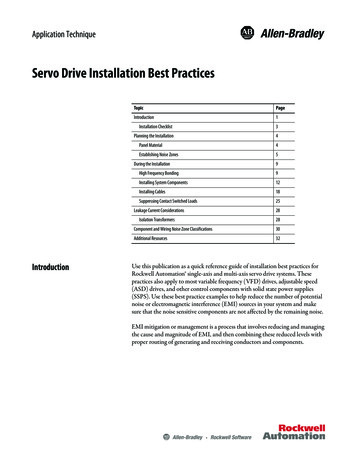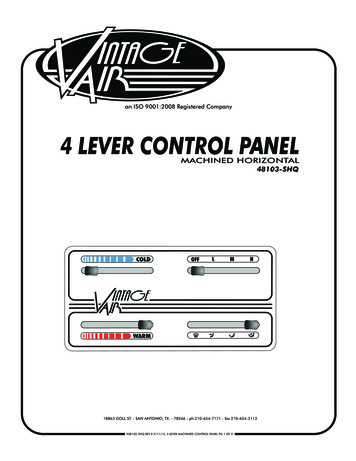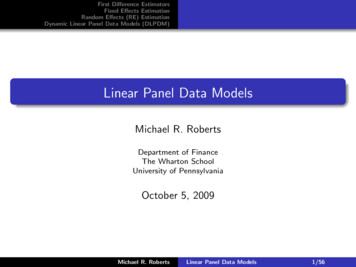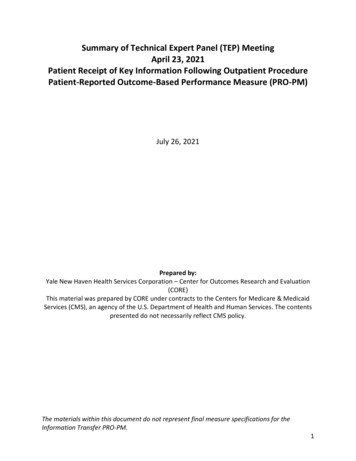
Transcription
Summary of Technical Expert Panel (TEP) MeetingApril 23, 2021Patient Receipt of Key Information Following Outpatient ProcedurePatient-Reported Outcome-Based Performance Measure (PRO-PM)July 26, 2021Prepared by:Yale New Haven Health Services Corporation – Center for Outcomes Research and Evaluation(CORE)This material was prepared by CORE under contracts to the Centers for Medicare & MedicaidServices (CMS), an agency of the U.S. Department of Health and Human Services. The contentspresented do not necessarily reflect CMS policy.The materials within this document do not represent final measure specifications for theInformation Transfer PRO-PM.1
Table of ContentsBackground . 3Measure Development Team . 3The TEP . 3Specific Responsibilities of the TEP Members . 4TEP Meetings . 5Overview of First TEP Meeting (April 23, 2021) . 5Next Steps . 8Conclusion. 8Appendix A. CORE Measure Development Team . 9Appendix B. TEP Call Schedule . 10Appendix C. Detailed Summary of TEP Meeting #1 . 11The materials within this document do not represent final measure specifications for theInformation Transfer PRO-PM.2
BackgroundThe Centers for Medicare & Medicaid Services (CMS) is developing a Patient-Reported OutcomePerformance Measure (PRO-PM) to assess the quality and content of information provided topatients as part of an outpatient procedure or surgery. Yale New Haven Health ServicesCorporation – Center for Outcomes Research and Evaluation (CORE) is leading the work undercontract to CMS. The contract name is Development, Reevaluation, and Implementation ofOutpatient Outcome/Efficiency Measures, Option Period 1. The contract number is HHSM75FCMC18D0042, Task Order Number HHSM-75FCMC19F0002.CORE is obtaining expert and stakeholder input on the proposed measure. The CORE MeasureDevelopment Team is composed of experts in the development and implementation of qualityoutcomes measures. As is standard with all measure development processes, CORE hasconvened a technical expert panel (TEP) of clinicians, patient advocates, and otherstakeholders. Collectively, the TEP members provide expertise in performance measurement,quality improvement, outpatient surgery, clinical care, care coordination and the patientexperience.This report summarizes the feedback and recommendations received from the TEP during thefirst meeting, which focused on the proposed measure development approach and theproposed measure domains.Measure Development TeamSteven Spivack, PhD leads the Measure Development Team. Dr. Spivack is an AssociateResearch Scientist for the Quality Measurement Team at CORE and has supported severalMeasure Development teams. The Measure Development Team is also composed of individualswith a range of expertise in outcome measure development, health services research, clinicalmedicine, and measurement methodology. See Appendix A for the full list of members for theCORE Measure Development Team.The TEPIn alignment with the CMS Measures Management System (MMS), CORE held a 30-day publiccall for nominations and convened a TEP for the development of a Patient Receipt of KeyInformation Following Outpatient Procedure PRO-PM. CORE solicited potential TEP membersvia emails to individuals and organizations recommended by the Measure Development Teamand stakeholder groups, email blasts sent to CMS physician and hospital email listservs, andthrough a posting on CMS’s website. The TEP is composed of 15 members, listed in Table 1.The role of the TEP is to provide feedback and recommendations on key methodological andclinical decisions. The appointment term for the TEP is from March 2021 to May 2023.The materials within this document do not represent final measure specifications for theInformation Transfer PRO-PM.3
Specific Responsibilities of the TEP Members·······Complete and submit all nomination materials, including the TEP Nomination Form,statement of interest, and curriculum vitaeReview background materials provided by CORE prior to each TEP meetingAttend and actively participate in TEP conference callsProvide input on key clinical, methodological, and other decisionsProvide feedback on key policy or other non-technical issuesReview the TEP summary report prior to public releaseBe available to discuss recommendations and perspectives following TEP meetings andpublic release of the TEP Summary Report to CMSTable 1. TEP Member Name, Affiliation, and LocationNameNichole BosticJill Dietz, MD, FACSRichard Dutton,MD, MBAPatricia Franklin,MD, MBA, MPHCaitlin Gillooley,MSPHBeth Godsey, MS,MBACharles Goldfarb,MDSherrie Kaplan,PhD, MPHOrganization (title); clinical specialty, if applicablePatient/Caregiver RepresentativeFormerly, Univ. Hospitals of Cleveland Seidman CancerCenter (Director, Breast Program); Breast surgeryUS Anesthesia Partners (Chief Quality Officer);AnesthesiologyNorthwestern Univ. School of Medicine (Professor; CoDirector, Outcomes & Measurement Hub); Research;Preventive medicineAmerican Hospital Association (Sr. Associate Director,Quality Policy)Vizient Inc. (Sr. Vice President, Data Science &Methodology)Washington University School of Medicine,Department of Orthopedic Surgery (Executive ViceChair); Orthopedic surgeryUniversity of California, Irvine (Psychometrician;Assistant Vice Chancellor, Healthcare Evaluation &Measurement); PsychometryJames Moore, MDUCLA Health (Physician); AnesthesiologyAnn O'ConnorPatient/Caregiver RepresentativeCarol Raphael,MPAKevin Schuster,MD, MPH, FACS,MCCMLocationAUGUSTA, GABENTLEYVILLE,OHDALLAS, TXCHICAGO, ILWASHINGTON,DCDALLAS, TXST. LOUIS, MOIRVINE, CALOS ANGELES,CALARCHMONT,NYManatt Health (Senior Advisor); NursingNEW YORK, NYYale School of Medicine/Yale New Haven Hospital(General Surgeon); General SurgeryNEW HAVEN,CTThe materials within this document do not represent final measure specifications for theInformation Transfer PRO-PM.4
NameOrganization (title); clinical specialty, if applicableUniversity of Michigan Department of Urology(Physician); UrologyLocationGina Throneberry,RN, MBA, CASC,CNORAmbulatory Surgery Center Association (ASCH)(Director of Education and Clinical Affairs); NursingALEXANDRIA,VAJorge Villegas,PhD, MBAUniversity of Illinois at Springfield (Associate Professorof Marketing, Patient Advocate, Research/Consultantof Health Communication and Access);Research/AdvocateSPRINGFIELD, ILJohn Stoffel, MDANN ARBOR, MITEP MeetingsCORE held its first TEP meeting on April 23 2021, at which the Information Transfer PRO-PMwas presented. CORE anticipates holding three additional TEP meetings between May 2021 andMay 2023 (see Appendix B for the TEP meeting schedule). This report contains a summary ofthe April 2021 TEP meeting.TEP meetings follow a structured format consisting of the presentation of updates on measuredevelopment and patient workgroup feedback, key issues identified during measuredevelopment, CORE’s proposed approaches to addressing the issues, followed by an opendiscussion of these issues by the TEP members.Overview of First TEP Meeting (April 23, 2021)Prior to the first TEP meeting, TEP members received detailed meeting materials outlining theproject overview, measure background, approach to the measure concept, and feedback fromthe first patient workgroup meeting.During the first TEP meeting, CORE presented relevant background information and patientworkgroup feedback and solicited input from the TEP on the measure domains, surveyapproach, and other relevant questions.Following the meeting, TEP members unable to join the TEP teleconference were provided withdetailed meeting minutes, and all TEP members were invited to provide any additionalfeedback by email.The following bullets represent a high-level summary of what was presented and discussedrelevant to the Patient Receipt of Key Information Following an Outpatient Procedure PRO-PMduring the first TEP meeting. For further details, please see Appendix C.The materials within this document do not represent final measure specifications for theInformation Transfer PRO-PM.5
···CORE presented an overview of the project and measure background to the TEP.o Dr. Spivack summarized CMS contracted CORE to develop an outpatientinformation transfer PRO-PM for the Ambulatory Surgical Center QualityReporting (ASCQR) and Hospital Outpatient Quality Reporting (HOQR) programsfollowing the generation of the concept in a 2018 series of focus groups.o Dr. Spivack reviewed the project overview, including the concept origin,definition of a PRO-PM, guiding principles for the project, a project timeline, andfurther detail on the TEP role.o Dr. Spivack reviewed the project background, including topic importance, howliterature provides evidence that better information transfer after proceduresleads to better patient outcomes, existing related measures, and validatedsurvey items available on the topic.o TEP Feedback:§ Several TEP member noted the importance of a quick and easy surveybuilt into the care process as part of a positive patient experiencefollowing outpatient surgery.o Dr. Spivack presented patient workgroup feedback thus far within the categoriesof discharge instruction content, discharge instruction format, and theirexperiences with surveys.Dr. Spivack reviewed five preliminary domains the measure could target as identified byCORE: basic information about the procedure; guidance for patient activity followingsurgery; things to monitor during recovery; medication information; and patientunderstanding of the instructions.TEP Feedback:o Several TEP members agreed that the proposed domains are reasonable for thefocus of this measure and capture concepts important to a successful discharge.§ One TEP member felt that some of the domains focus on a “standard”post-operative course, although expectations can diverge in the case ofcomplications.§ One TEP member suggested reframing the questions to ask patientswhere they got information after the procedure rather than assumingthey got it from their provider’s instructions.§ One TEP member re-emphasized considering which outcomes are mostimportant from the patient perspective.o Several TEP members emphasized specific domains as reflecting key concepts:§ Several TEP members emphasized patient understanding of theinstructions as a key domain for the measure to capture, andrecommended the measure capture that concept rather than simplyassess whether patients received particular instructions.§ One TEP member said providing clear information to contact a provider ifsomething goes wrong is particularly important.The materials within this document do not represent final measure specifications for theInformation Transfer PRO-PM.6
§Several TEP member said that clear instructions for medication areimportant because medication management is complicated and closelylinked to outcomes.o Several TEP members noted that information about the recovery periodprovided before a surgery can be very helpful as it allows patients and caregiverstime to process the information and prepare.o Several TEP members noted that considering the perspective of caregivers (whoface different challenges in the post-surgery period) is important for themeasure, particularly for patients with cognitive impairments.o Several TEP members noted that there is great variety in both the types ofproviders this PRO-PM would measure and the types of surgeries or procedureseven within a facility or specialty.§ One TEP member noted that many ambulatory surgical centers (ASCs) arerural facilities with less resources and performing fewer procedures thanhospital outpatient departments (HOPDs) and requested the measurepilot be expanded to include ASCs.· Another TEP member agreed and said that while a separatesurvey may not be necessary, findings among HOPDs may nottranslate seamlessly to the ASC setting.· CORE noted that providers will likely administer surveys through athird-party vendor, minimizing reporting burden to providers.While CORE will initially pilot the measure among HOPDs only, wewill consider what other testing or adaptation is necessary toadapt to ASCs.§ One TEP member noted that expectations in the discharge process can becomplicated based on the dynamics between surgeons andanesthesiologists, with important information potentially lost.§ One TEP member expressed concern about the feasibility of developing asurvey that is sufficiently focused while also broadly useful acrossspecialties.§ One TEP member stated concern that differences among patientpopulations could impact responses.· CORE recognized the importance of this comment and noted thetopic of disparities will be discussed at a future TEP meeting inmuch greater detail.§ One TEP member noted that accurate attribution and validation of resultswill be key to making this a good measure, as will information to guideproviders in improving care.§ Several TEP members noted the lack of standardization in dischargeinstructions across outpatient providers.· CORE noted the variation among providers reflects room forimprovement. The purpose of the measure is not to promote aThe materials within this document do not represent final measure specifications for theInformation Transfer PRO-PM.7
·uniform approach, and variation among providers is acceptable aslong as patients’ needs are being met.o Several TEP members offered input on making the survey more patient-friendlywhile capturing relevant information:§ Several TEP members recommended using a short survey (fewer than 10questions). One member also advised avoiding redundant questions.§ Several TEP members recommended pushing the survey to patientssometime between a few days and one week after discharge to capturethe best information.§ One TEP member suggested following up dynamically to assess outcomesat several points in time following surgery.§ One TEP member noted there are many possible questions within theidentified domains and recommended CORE focus on the specificpurpose of the measure when developing the questionnaire.· CORE summarized this purpose as addressing a gap (identifiedthrough previous engagement with multiple focus groups)between inpatient and outpatient settings in basic informationprovided to patients after a procedure leading to frustration andrisk.§ One TEP member recommended highlighting the purpose andimportance of the survey in effecting future changes to encouragepatients to respond.Dr. Spivack thanked attendees and outlined the next steps for the TEP and the measuredevelopment process.Next StepsOngoing Measure DevelopmentCORE will continue to encourage further feedback and questions from TEP members via emailuntil the next TEP meeting. Additionally, CORE will continue to engage stakeholders in a PatientWorking Group to solicit feedback on various survey aspects.ConclusionTEP feedback of CORE’s approach to measure development will inform the measure survey.CORE will continue to engage and seek input from the TEP as the measure is developed.The materials within this document do not represent final measure specifications for theInformation Transfer PRO-PM.8
Appendix A. CORE Measure Development TeamCenter for Outcomes Research and Evaluation (CORE) Team MembersNameSteven Spivack, PhDKyle Bagshaw, MPHLeianna Dolce, BSPhylicia Porter, MPH, MSLDoris Peter, PhDFaseeha Altaf, MPHElizabeth E. Drye, MD, MSZhenqiu Lin, PhDTeam RoleProject LeadProject CoordinatorResearch Assistant IIContract ManagerConsultantProject ManagerSenior DirectorAnalytic DirectorThe materials within this document do not represent final measure specifications for theInformation Transfer PRO-PM.9
Appendix B. TEP Call ScheduleTEP Meeting #1Friday, April 23, 2021 – 3:00-5:00PM EST (Zoom Teleconference)TEP Meeting #2TBDTEP Meeting #3TBDTEP Meeting #4TBDThe materials within this document do not represent final measure specifications for theInformation Transfer PRO-PM.10
Appendix C. Detailed Summary of TEP Meeting #1Friday, April 23, 2020 3:00 PM – 5:00 PM ETParticipants···Technical Expert Panel (TEP) Members: Nichole Bostic, Jill Dietz, Richard Dutton, PatriciaFranklin, Caitlin Gillooley, Beth Godsey, Charles Goldfarb, James Moore, Annie O’Connor, CarolRaphael, Kevin Shuster, John Stoffel, Gina Throneberry, Jorge VillegasYale New Haven Health Services Corporation – Center for Outcomes Research and Evaluation(CORE): Faseeha Altaf, Duwa Amin, Kyle Bagshaw, Leianna Dolce, Elizabeth Drye, Zhenqiu Lin,Phylicia Porter, Steven SpivackThe Centers for Medicare & Medicaid Services (CMS): Cyra Duncan, Janis GradyDetailed Discussion SummaryWelcoming Remarks···Mr. Kyle Bagshaw welcomed the group on behalf of CORE and introduced Dr. Steven Spivack,who was facilitating the meeting after introductions.Mr. Bagshaw reviewed the meeting agenda and reminded the group that the content of TEPdiscussions must remain confidential until made public by CMS and that all personal opinionsand experiences, including any personal health information shared during the TEP meeting areto remain confidential. He stated that TEP members are representing themselves and not theorganizations with which they are affiliated.Mr. Bagshaw reviewed the goals for the meeting including completing introductions of the COREteam and TEP, reviewing of the project and measure background, and obtaining TEP feedbackfor measure development.Introductions···Mr. Bagshaw summarized CORE’s mission and each member of the CORE team introducedthemselves.Ms. Janis Grady (CMS) introduced herself.TEP members briefly introduced themselves and described their key interests related to themeasure. Members also disclosed any potential conflict of interest (COI).Project Overview·Dr. Spivack reviewed the project origin, noting it was derived from a measure conceptgeneration task beginning in 2018. In conducting this task, CORE met with a variety ofstakeholders including patients, clinicians, outpatient executives, and researchers. This processmade it clear that patients getting outpatient surgeries or procedures often are not receivingthe quality of discharge instructions they should be, and this is an area that could usemeasurement and improvement.o A measure in this area falls under the CMS Meaningful Measure Area of Transfer ofHealth Information and Interoperability.The materials within this document do not represent final measure specifications for theInformation Transfer PRO-PM.11
This project aims to develop a PRO-PM about outpatient surgery and proceduredischarge instructions utilizing a patient survey. This will involve multiple patientworkgroup meetings and two to four TEP meetings over the next three years.Dr. Spivack broke down the definition of a “PRO-PM” to highlight that it is a “patient-reported”(something subjective a patient experiences and only they can rate) “outcome” (something thatoccurs after surgery) “performance measure” (a measure comparing one provider to another tosee who is better at doing the right thing, at the right time, in the right way, for the right person,and getting the best possible results).Dr. Spivack outlined the guiding principles of the project – to develop a survey that is: patientcentered; as burdenless as possible for providers; as short as possible while capturing allrelevant items; and developed in a diverse and representative population.Dr. Spivack reviewed the three-year project timeline noting milestones including conducting thefirst patient workgroup and TEP meetings, drafting the survey, a soft pilot of the survey, furtherdeveloping the survey, a first round of pilot testing, reviewing pilot results and adjusting thesurvey as needed, and conducting an additional pilot and survey adjustment, ending in 2023with submission to the National Quality Forum (NQF).In further detail, Dr. Spivack reviewed the TEP role for this project. The purpose was noted toprovide stakeholder input and contribute to transparency. The member responsibilities werespecified as reviewing materials and attending meetings, providing input on key measureattributes, reviewing TEP Summary Reports prior to public release, and maintainingconfidentiality of materials.o····Approval of the TEP Charter·Members approved the charter unanimously.Project Background··Dr. Spivack reviewed background information on the project, noting CMS has focused on makingsure patients are receiving the information they need from providers. The best way to makesure this is occurring is to ask patients directly, which this project aims to do. He noted this is animportant focus as poor communication of information from the outpatient facility to patientscan make recovery more difficult for the patient.o Often after procedures, patients are coming out of anesthesia or have had a stressfulevent, making it difficult to focus and retain what providers are communicating.Discharge instructions provide a second opportunity for patients and caregivers to seeand digest information vital to recovery, including steps that are important to follow forsafe recovery.o Literature related to discharge instructions shows low quality or missing information isassociated with more medication errors, infections, worsening of a medical condition,and readmission.Reviewing a conceptual model of how better information transfer can improve patient andhealth system outcomes, Dr. Spivack began by identifying the discharge instructions themselvesas the input. Receiving these instructions can help improve communication and carecoordination. In turn, this can increase patient agency and ability to manage their recovery. Thisthen leads to better health outcomes including reduced medication errors, complications, andThe materials within this document do not represent final measure specifications for theInformation Transfer PRO-PM.12
··readmission. The resulting patient outcomes include better patient health and experiences,while the system outcomes include improved population health and lower unnecessaryspending.Dr. Spivack noted, after completing a thorough literature review, no current measures werefound that solely focus on the quality and/or content of outpatient discharge instructions.o Similar content was found in an Inpatient Psychiatric Facility Quality Reporting Programmeasure which is more of a process measure. Additionally, the Hospital ConsumerAssessment of Healthcare Providers and System (HCAHPS) survey includes somerelevant questions.o There are also validated surveys that are currently used voluntarily including the HealthInformation National Trends Survey which focuses mainly on cancer related care, andmultiple CAHPS surveys including the emergency department, outpatient, and surgicalversions which may include relevant questions.o Non-validated surveys have also been identified in academic studies and individualhospital and health system surveys.o Dr. Spivack reviewed specific CAHPS questions that may be applicable to this measure.TEP members made the following comments and suggestions:o A TEP member shared that they felt having a quick and easy survey is important as wellas building the survey into the process would eliminate possibility of survey fatigue. Thismember referenced a Josie Robertson Outpatient Surgery Center at Memorial SloanKettering which phenomenally builds their surveys into their process.§ A TEP member responded their relatives have been patients at this center andhave positively noted the engagement with their patients which gets built intothe process. These patients tend to feel less informed when their proceduresare done elsewhere.Patient Workgroup Feedback·Dr. Spivack reviewed the feedback obtained from the seven-member patient workgroup in themeetings held a few weeks prior. He noted that many of these patients work in the healthcare fieldin addition to having received numerous outpatient procedures, allowing for an even morecomprehensive view of their experiences. This included three main categories of feedback:discharge instruction content, discharge instruction format, and the survey instrument.o All patients noted the instructions were important and often referenced during recovery.This effect was heightened during COVID when family and caretakers have not been allowedin the facility. Sections regarding medication instructions, warning signs, follow-up care, andpain management were noted as being most important. Additionally, the patients wantedelectronic and more personalized instructions.o Patients prefer to have instructions with clear sub headers and formatting that is not toolong or too short. The instructions and writing also need to be clear.o All patients agreed they are experiencing survey fatigue in all facets of their lives. Related tothis, they prefer short surveys with notice of the length upfront. It was noted that electronicsurveys are preferred but that would be difficult for many older patients, some of whommay require a paper copy if they were to complete it. Patients also found it important toThe materials within this document do not represent final measure specifications for theInformation Transfer PRO-PM.13
have an option for caregivers to respond and to help patients understand why theirfeedback is important and how it will help future patients.TEP Input··Dr. Spivack stated that CORE is looking for input on measure domains, survey approach, andadditional topics. CORE is considering five potential domains based on concepts that theliterature documents as either often missing in outpatient discharge instructions or that have amajor impact on outcomes:o Basic information about the procedure (such as the procedure name, reason, physician,results, and complications);o Guidance for what the patient should do after surgery (such as diet, exercise, activitiesof daily living, returning to work, and follow-up visits);o Things to look out for during the recovery process (such as normal symptoms versusdangerous symptoms, wound care and pain management instructions, and who tocontact if needed and when);o Information about medications (such as when to start or stop, dosages, dates and times,and risks and side effects); ando Patients’ understanding of their instructions (if the instructions were understood, toldpatients what to expect, were easy to read, or were too short or too long).Dr. Spivack asked the TEP to share their thoughts on the potential domains.o One TEP member stated that the proposed domains seem reasonable. They said thatpatients want clear and concise instructions when they get home and gave an exampleof good instructions that included a schedule for eyedrops after an eye surgery,including a picture of each medication.o One TEP member agreed with highlighting the importance of the survey for patients andthat it can impact change in the future. They also noted from experience thatsometimes patients and families do not understand why some pre- or post-opinstructions are necessary, even though better understanding of this can lead to bettercompliance.§ Dr. Spivack responded that we can consider asking patients if they understandthe reason for their instructions in the survey.o One TEP member noted the goal of this measure is to evaluate post-op information butsome of the domains seem to focus more on pre-op expectations; expectations willactually diverge post-op based on if there were any complications and it may be good tolook at divergence from a standard post-operative course.o One TEP member noted that needs and experiences vary from different types ofsurgeries, and asked if the measure’s scope will be strictly for the outpatient setting.§ Dr. Spivack confirmed that the measure is only focused on outpatient surgeriesand agreed that there is great heterogeneity among the types of procedurewithin these settings.o One TEP member noted it is hard to anticipate what happens when a patient gets home,and so it is important for patients to have information on who to contact forinformation if something unexpected happens. They also noted the importance ofThe materials within this document do not represent final measure specifications for theInformation Transfer PRO-PM.14
·distinguishing between the experience of the caregiver and the patient, as somecaregivers may not feel well-prepared for complicated care. In particular, some patientshave cognitive impairments and cannot manage their own aftercare.§ Another TEP member agreed that considering the caregiver in early post-op careis important when framing the survey questions.o One TEP member noted that changes to a patient’s regular medication regimen is aparticular risk for complication or hospital admission in the post-op period. Post-opmedication management is very complicated and closely related to downstreamoutcomes. They would like this measure to not just measure “satisfaction” but look atwhat a patient actually understands about what has changed in their care.o One TEP member sta
Ann O'Connor. Patient/Caregiver Representative LARCHMONT, . University of Illinois at Springfield (Associate Professor of Marketing, Patient Advocate, Research/Consultant . Research/Advocate SPRINGFIELD, IL. TEP Meetings. CORE held its first TEP meeting on April 23 2021, at which the Information Transfer PRO-PM was presented. CORE .


